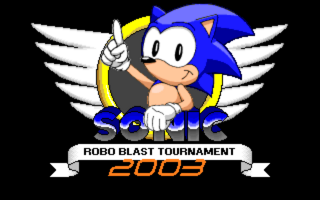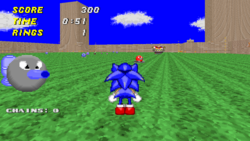SRB2 Tournament 2003

SRB2 Tournament 2003 (abbreviated as SRB2 2k3) is an outdated version of SRB2, released in March 2003. It was a multiplayer-only demo released exclusively to the Sonic Amateur Games Expo (SAGE) to show off the new multiplayer features, including weapon rings and Chaos mode. The name of this demo is a reference to Unreal Tournament 2003, the then-current entry of the Unreal Tournament first-person shooter series.
SRB2 2k3 can be considered a strong precursor to the Final Demo series of SRB2 demos, as the improvements shown in this demo are also very characteristic of how advanced the Final Demo series became in comparison to Demo 4.35 and other past demos. The Single Player option in the main menu does not function, unless a custom level in the MAP01 slot is loaded into the game, as SRB2's own Single Player levels were not included in this demo; however, the Single Player and Coop gametypes themselves were still playable, and some of v1.01's new features for them were already implemented in this demo.
New features
SRB2 2k3 implemented a thought-out system for the multiplayer roster, so there were maps specifically designated for their respective gametypes. A new numbering system for multiplayer maps came into play in this demo: the MAP7x slots were reserved for Chaos stages, MAP8x slots were reserved for CTF stages, and MAP9x slots were reserved for Match stages.
Weapon rings
Weapon rings were added to Match, Tag and Capture the Flag in SRB2 2k3. Originally, the following weapon rings were included:
- Automatic Ring: Can be fired at a rapid rate, resulting in a constant stream of rings.
- Explosion Ring: Explodes when touching a surface, damaging any player in the vicinity.
- Homing Ring: Moves very slowly, but homes in towards the nearest player.
- Infinity Ring: Can be fired without depleting the player's ring supply.
- Rail Ring: Instantly hits any player in the firing player's line of sight.
The weapon ring lineup would remain unchanged until the release of v2.0, which dropped Homing and Infinity and added Bounce, Grenade and Scatter. In the IRC Match beta, which had the purpose of testing v2.0's new weapon system, these changes were already in place, except for the removal of Infinity. The Infinity Ring was subsequently re-added in v2.1.
The original implementation of weapon rings was very different to the system implemented from v2.0 onwards: Instead of panels and ammunition pickups, the weapon rings were placed directly on the map. Picking up a weapon ring would change the player's fired rings into the collected weapon for a limited time (the timer was displayed on the HUD). No further ammunition was required to fire the weapon rings. Collecting an already active weapon ring again would extend the timer. If the player was hit without a shield, they would drop all active weapon rings along with their regular rings. If a dropped weapon ring was picked up again, either by the player who lost it or an opponent, the timer would continue at the point where it stopped when the weapon was dropped.
The characteristic feature of this weapon ring system was that if the player held more than one weapon ring at the same time, the effects of the weapons would be combined. For example, combining Homing and Explosion would result in a weapon that homes in on the nearest player and additionally explodes when touching a surface, while combining Rail and Automatic would result in a Rail Ring that could be fired at much shorter intervals than normal. It was also possible to combine three or more weapons, or even all weapons at once. Many of these combinations were considered overpowered, so levels at the time usually featured only one or two types of weapon rings at once, and only specific combinations were used at all.
Chaos

SRB2 2k3 introduced Chaos mode, a gametype that would be later be disabled in v1.09 due to poor reception. In this gametype, random enemies (and sometimes bosses) would spawn from designated spawn points and players would compete to kill these enemies for a high score. Killing multiple enemies in one move would increase the score rapidly, while dying halved it. Six levels were added specifically for Chaos mode in SRB2 2k3, generally built to be smaller and simpler than Match maps, though the gametype could also be played on all Match maps themselves.
Digital music
SRB2 2k3 was the first public release to include digital music, using the Ogg Vorbis format, as the default type of music played; previous versions (except SRB2 Christmas v0.96, which was released on CD) had included only MIDI music. 2k3 itself included only Ogg music in contrast, but for all versions afterwards Ogg and MIDI versions would be included for most music in the game.
SRB2 2k3 also introduced a new slot numbering system for music lumps. Instead of using the pre-defined music lump names held over from Doom II (e.g.: D_RUNNIN for MAP01, D_STALKS for MAP02, D_COUNTD for MAP03), the lumps for the first 99 music slots now were generally named after their maps – i.e.: O_MAPxxM, xx being the corresponding map number. Several exceptions existed to this rule: the secret NiGHTS level's theme was named O_NIGHTS, while Meadow Match's theme was named O_BATTLE. Subsequent music slots (from 100 onwards) all had special lump names to indicate their purpose, e.g.: O_TITLES. However, since the newly-added level headers did not yet support customizable music for levels, several music tracks were hardcoded to take up multiple slots for use by the multiplayer maps.
Other
- High-resolution flats (those bigger than 64×64) were now supported in 2k3, allowing SRB2 to include larger, higher-quality versions of flats such as GFZ's grass floor.
- Level headers were introduced in this demo. At this point, they were just simple text lumps named
MAPxxN(xx being the map number it applies to), giving the name of the level and the act number. Future versions would expand on this feature, and it was later implemented as part of the scripting language SOC. The introduction of level headers also made 2k3 the first demo in which multiplayer maps had names. Formerly, the multiplayer maps did not have names, as giving maps a name required extensive graphic resource editing for the title cards. Then, with the level header system, maps could be named simply by typing out an entry in the header, which would prompt the game to automatically generate a title card. - Making use of the above feature, the Host Game and Two-player Game menus now displayed each level's name and act number when the level is selected, instead of its map number as in previous versions.
- 2k3 also had a secret NiGHTS level. It was an extremely early version of Spring Hill Zone. At this point in development, the NiGHTS system was still in the process of being coded. Hoops were generated with a very preliminary generation algorithm.
- The then-existing shields were given proper names to reflect their abilities, instead of being referred to by their color: the blue shield was called the Basic Shield, the yellow shield was called the Attraction Shield 1, the green shield was called the Liquid Shield 1 and the black shield was called the Armageddon Shield. A new red shield, known as the Inferno Shield, was added in this version; this shield protected the player from fire damage, and left a trail of flames behind the player when spinning on the ground (outside of water).
- Besides the new shield, several new monitors were added in this version: the Teleporter Monitor, the Random Monitor and the Eggman Monitor.
- Many new options were added to the
S_SKINlump for character skins, such as values specifically for the character's top speed and acceleration (in place of a single "speed" value that gave a character pre-determined speed stats), a value to enable/disable the spindash, and the strength of a character's jump (as a percentage of the default). The ability to define a custom range of palette indexes that change color in multiplayer was also added, allowing characters such as Knuckles to remap palette indexes other than the Green range to the skin color for the first time; before 2k3, Knuckles' socks, which were green, changed color instead of his body. - Some of the existing skin colors that players could use in multiplayer were renamed in 2k3: Light Red and Light Blue became Red and Blue, while the old Red and Blue became Dark Red and Dark Blue. In addition to this, two new skin colors were added: Purple and White. To reflect the fact that sprites for characters no longer needed to be Green by default, the skin color Green (which was really just the sprite's appearance without a skin color) was renamed to Default, and a new Green skin color was added to explicitly color a character green.
- Despite Single Player/Coop levels not being included in 2k3, some of the new features for these gametypes introduced in the following version were already implemented: Star Posts, the new score tally screen, continues and the corresponding continue screen.
- The "Sonic Team Jr. Presents" screen shown when the game starts up was redrawn. The help screen that appeared when F1 was pressed, previously only telling the player to look at the included readme.txt file, was replaced with a new screen giving useful information for Single Player and multiplayer (despite Single Player levels not being included in 2k3). Also included ready for the next version, but unused in 2k3, were graphics for the new intro cutscene and the Final Demo post-credits cutscene.
1 The manual introduced in the following version referred to the yellow and green shields as Magnetic Shield and Elemental Shield respectively, and would continue to do so until v1.09, when the manual was updated to match the in-game names.
Levels
Chaos levels
- MAP70: Flying Shrine Zone
- MAP71: Woodland Panic Zone
- MAP72: Ring Lake Zone
- MAP73: Block Factory Zone
- MAP74: Air Haven Zone
- MAP75: Submerged Temple Zone
Capture the Flag levels
- MAP80: Lime Forest Zone
- MAP81: Dual Fortress Zone
- MAP82: Vine Cavern Zone
- MAP83: Iron Turret Zone
Match levels
- MAP90: Sky Temple Zone (Later renamed to Airborne Temple Zone)
- MAP91: Meadow Match Zone
- MAP92: Conveyor Chaos Zone
- MAP93: Green Upheaval Zone
- MAP94: Starlit Warehouse Zone
- MAP95: Seafloor Sanctum Zone (Later renamed to Submerged Sanctum Zone)
Other
- MAP31: NiGHTS
External links
- Archived Versions – srb2.org – Information and download
- Alternative Download – Note: Several addon files (not found in the srb2.org download) dating from the time of 2k3's release are included in this ZIP archive.
| Versions | [view] | |
| Pre-demo | SRB2 TGF • SRB2 Halloween • SRB2 Christmas | |
| Demo | Demo 1 • Demo 2 • Demo 3 • Demo 4 • Demo 4.32–4.35 • SRB2 2k3 | |
| Final Demo | Final Demo 1.01–1.04 • Final Demo 1.08 • Final Demo 1.09–1.09.2 • Final Demo 1.09.3–1.09.4 | |
| Post-demo | Match beta • Version 2.0 • Version 2.1 • Version 2.2 • In development | |
